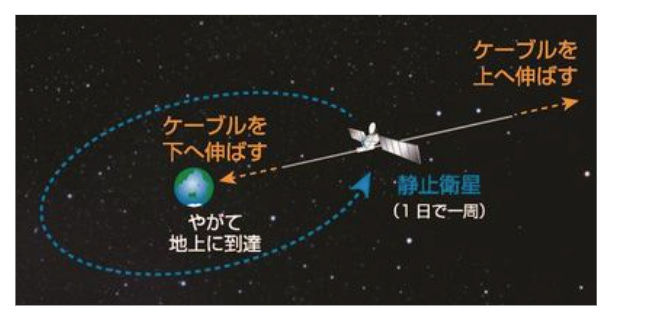
Space Elevator from JSEA
Get ready for yet another space-themed newsletter. Sorry (not sorry), but I have this thing where I get super curious about something and just dive deep into it, often getting a bit too consumed, haha. Space never used to grab my attention, but I guess everything has its time and process. Timing really is everything, isn't it? Today, we're exploring something mind-blowing: a Japanese company (Japan Space Elevator Association) which is working on building a space elevator. Yeah, you heard that right. Some might wonder, "Why does this matter?" or even, "Is this actually possible?"
The concept of a space elevator has been envisioned by various scientists and authors in the past. Is just that I did not know it until now :D. The first one who proposed this idea in 1895 was Konstantin Tsiolkovsky, inspired by the Eiffel Tower, imagining a "celestial castle" connected to Earth by a spindle-shaped cable. Soviet engineer Yuri Artsutanov later expanded on this in 1960, detailing a cable with a counterweight extending from a geostationary satellite to Earth.
The concept gained popularity through Arthur C. Clarke's 1979 science fiction novel "The Fountains of Paradise." Additionally, American engineer Jerome Pearson and physicist Bradley C. Edwards have significantly contributed to the space elevator's theoretical development, with Edwards conducting NASA-funded feasibility studies in the early 2000s.
Fair warning: I'm going to throw in some physics jargon, but trust me, it's fascinating stuff. So, here's what this newsletter will cover:
Intro on Space Elevators
How Will the Space Elevator Benefit Humanity?
Intro on Space Elevators
Space or orbital elevators, once a far-fetched idea, are now closer to reality thanks to technological advancements. Unlike rocket-based space travel, which carries risks of crashes and pollution, space elevators offer a safer, cleaner way to connect Earth and space, like a towering link between ground and sky. This innovation could revolutionize space exploration, potentially allowing even non-astronauts, including the elderly or disabled, to experience space.

Photo credit: Space Elevator Association
The principle of a space elevator is simple: it uses a satellite in Earth's orbit, balanced by Earth's gravity and centrifugal force, to create a stable, circulating pathway between Earth and space. This is a great short video if you want to know more about how satellites work.
Objects in orbit, like satellites, don't fall back to Earth because the centrifugal force from their motion balances with Earth's gravity. For instance, the International Space Station orbits at 400 km above Earth, traveling at 28,000 km/h to circle the planet every 90 minutes, or about 16 times a day. In contrast, geostationary satellites, positioned 36,000 km above the equator, orbit at 10,800 km/h. This speed matches Earth's 24-hour rotation, making them appear stationary in the sky, hence the term "geostationary."
Imagine attaching a cable from such a satellite to the Earth. The cable's weight could pull the satellite towards Earth. To prevent this, extend the cable in the opposite direction for balance. By lengthening both sides, the cable eventually reaches Earth, creating a 'space elevator'. This simple concept involves a cable-based lift for transporting people and goods between Earth and space.

Many may ask why this idea was not done before? Reason for this were the technical challenges like the lack of a strong cable material. However, now we have this material and is carbon nanotubes which were discovered in Japan in 1991. This breakthrough has sparked increased discussion and the proposal of various construction plans. In the United States, researchers hold international conferences and annual competitions to advance space elevator technology. Seen as an ideal way to transport people and goods between Earth and space, experts believe there are no impossible obstacles to achieving this. Organizations like the Japan Space Elevator Association (JSEA) are dedicated to researching and promoting space elevators, working towards their eventual realization as a key transportation method for space exploration.
How Will the Space Elevator Benefit Humanity?
The space elevator could revolutionize how humanity accesses space. Modern rockets, like the Space Shuttle, carry a disproportionate amount of fuel; to launch 29 tons into low orbit, it uses 1,900 tons of fuel, achieving just a 1.5% efficiency. The cost of such transportation is around 1.7 million yen(~7000$) per kilogram for low orbit, and for Japan's H2A rocket, it's about 1.05 million yen(~6500$) per kilogram of cargo.
The cost of constructing and operating a space elevator is still uncertain, but estimates suggest it could be around 1 trillion yen(~650 Million Dollars), similar to the cost of building the Tsukuba Express(Japanese Railway which connect Akihabara, Tokyo- Tsukuba, Ibaraki). Unlike rockets, space elevators could use motors for ascent, eliminating the need for rocket fuel. This method could frequently lift about 20 tons of cargo. If it could manage about 50 ascents annually, the cost might drop to 10,000 yen per kilometer, and with 100 ascents to 5,000 yen – comparable to a first-class flight across the Pacific.
The construction cost of subsequent space elevators could drop by about 40% using the first one. With each additional elevator, from the second to the third and so on, the cost might eventually decrease to around 1,000 yen per kilometer. This reduction makes previously expensive projects more feasible:
Solar power generation satellites, a field where Japan leads in research.
Space tourism, including space tours and stays in space hotels.
Industries leveraging zero or low gravity environments.
Affordable space access could eventually enable human expeditions to the Moon and Mars. Smaller, less expensive space elevators could be constructed on these celestial bodies due to their lower gravity.
Looking ahead, the next generations of humanity could see our presence expanding throughout the solar system.
Reference used for this article :


